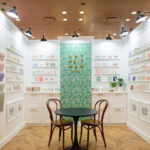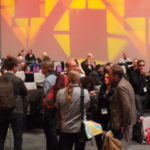
When it comes to technology, the Cardiovascular Research Foundation (CRF) aims to be on the bleeding edge. Take apps. CRF, which organizes the annual Trans-catheter Cardiovascular Therapeutics (TCT) conference — the world’s largest educational meeting specializing in interventional cardiovascular medicine — has been offering apps for the past “four or five years,” according to Johnnie White, CMP, executive director of CRF’s Center for Education.
The idea for TCT 2013, held Oct. 27-Nov. 1 at San Francisco’s Moscone Center, was to take apps “a step further,” White said, “and provide attendees with the platform that they would use their app on.” In other words, buy tablets for all 11,500-plus attendees.
“We didn’t know if that would [be feasible], because it is expensive,” White said. “We’re purchasing a lot of tablets.” But the more he and his colleagues thought about it, the more worthwhile they thought the investment would be, because they weren’t considering the tablets as a one-off proposition. “We were thinking beyond the meeting,” White said. “How can we continue to provide education? We thought that if we gave attendees the device, they could use it 365 days out of the year because we could continually send [educational content] to them.”
That meant developing an app for all of CRF’s meetings throughout the year, enabling TCT attendees to use their tablet to access content from those meetings — as well as an app for CRF’s “robust website, TCTMD, where cardiologists go to see what’ s going on in the world of cardiology,” White said. Thinking of the tablet as a means of providing education for cardiologists throughout the year “kind of helped us make the decision that this would be an investment for the future.”
White and his team talked to a number of tablet companies before deciding to work with Samsung. “Samsung really came to the table as a partner rather than just selling us the device,” he said. As part of the partnership agreement, Samsung uploaded several apps to each Samsung Galaxy Tab 3 tablet prior to TCT 2013: the meeting app itself, the TCTMD web app, and an app with an electronic calendar of all the different cardiology meetings held around the world throughout the year. When TCT attendees received their tablet at the meeting, the apps were already set up for them.
White and his team based their tablet order quantity on past TCT attendance, which is usually close to 12,000. Since only fully paid registrants attending TCT for the full week would receive a tablet — not exhibitors working a booth or someone coming in for a day or a special program — 10,500 tablets were ordered. The tablets were not intended to be an incentive to increase attendance, White said, but an added value. And, he noted, TCT 2013 attendance was actually a little lower than the previous few years — approximately 11,500 attendees, compared to 11,700 in 2012 and 11,900 in 2011.
ACROSS THE POND
Once CRF announced that tablets would be provided to TCT attendees, “the story got interesting,” White said. “We started to learn about guidelines that we thought weren’t an issue, but they actually were.” About 10 percent of TCT attendees are cardiologists from Europe. CRF had an unexpected challenge with Eucomed (eucomed.be), which establishes medical-technology guidelines in Europe that medical-device companies and some pharma companies have to follow. “The guidelines state that the health-care provider or physician cannot accept gifts that are more than 30 euros in value,” said White, who at first didn’t think that would present a problem, because CRF was providing the tablets — not a medical-device or pharma supplier.
“But if you look a little deeper,” White said, you learn that “most physicians outside of the United States don’t pay for their registration fee [for conferences]. A pharmaceutical or device company pays for their total cost, their registration fee, their travel, which could be airfare, and their hotel. So, the perception was that the company that was paying the registration fee was providing these tablets to the physicians as gifts.”
Obviously, that perception was incorrect. CRF had made the decision to purchase the tablets in June or July, several months after the TCT registration fee had been set. “We as an organization were taking our own money to invest in buying these tablets,” White said. “It was not included in the registration fee, because if it was, we would have raised the registration fee in order to cover this cost. So we presented that to the European organization, and we came to a compromise. The European physicians could use the tablets during the meeting, but at the end of the meeting, they had to return them — either back to the company who supported them, or back to us. We ended up getting a fair number of tablets back from these individuals [at the end of TCT 2013], who couldn’t keep them because of these guidelines.”
White said he “had no idea that this would be an issue initially, because we looked at this as, we have just replaced a printed book. We’re giving you a living program, and you’re going to be able to access the content throughout the week. We didn’t see it as a gift that they would use for other things. They could — the tablets have the capabilities to do that. But our goal was to give them something that they would use [exclusively] to access our education.”
GUNS ‘N’ TABLETS
The logistics involved in housing and transporting the tablets to San Francisco also proved tricky. New York City-based CRF had the tablets delivered to New York for tax purposes. “We had a hell of a time,” White said, “trying to find a warehouse that would house 10,000 tablets for a few weeks. What I found out through insurance companies, and as I was talking to the warehouses, was that tablets are probably the No. 1 stolen [item] right now. So a lot of the warehouses did not want that liability. We were lucky, though. We did find one at the last minute that was able to take them for us.”
Insuring the tablets on their trip from New York to San Francisco was equally difficult. “Again, this is such a high liability or high risk,” White said. “A lot of insurance companies wouldn’t do it, or they were establishing requirements where you had to have two drivers, the truck could never stop, and the drivers would have to carry guns.” White ended up finding an insurance company to work with — and no guns were required.
Once the tablets had safely arrived at the Moscone Center and were set up for attendees to use, there was another hiccup. “We were caught off guard on site,” White said. When attendees arrived at the Moscone Center, got their tablet, and started signing into the app, a lot of them didn’t remember their username and password. In hindsight, White realized that once you sign into a website and you click on “remember me,” you never really need to plug in your user-name and password. “Every time you get on the computer, it logs you in,” he said. “We were slammed probably the first two days with people coming up to our help desk,” looking for their user-name and password. White added more staff at the help desk, who “ended up just resetting a lot of people’s passwords in order for them to have access to the content pretty quickly.”
One potential challenge that White and his team had foreseen and made plans to accommodate was that the majority of TCT attendees have Apple devices and would be unfamiliar with an Android product. “We knew we would have a number of people that would need training on how to use [the tablet], as there are some differences between iOS and Android,” White said. “We ended up hiring an army of temporary staff that had some technical skills and trained them pretty much all day prior to us opening on the tablet and our app. We set up tech bars throughout the convention center and placed the temps there to help attendees set up their tablet — when you first start an Android device, you have to set up a Gmail account — provide tips about the app, and answer any questions. We also set up screens looping through a demonstration video on how to set up the tablet and navigate the app. That was pretty successful, as we had a number of people sitting down in front of the screens watching the video in addition to asking our temps questions.”
MOVING FORWARD
Now that TCT has wrapped up and attendees have their tablets, CRF is making sure to give them reasons to keep firing them up. They receive push notifications about new content on the TCTMD website. And since the TCT app is actually a multi-meeting app, it will enable users to access content from a number of meetings that CRF organizes throughout the year, including the smaller CTO (Chronic Total Occlusion and Left Main Summit 2014, Feb. 27-March 1, at the New York Marriott Marquis). Once multimedia content is available for CTO, tablet owners with the TCT app will receive a push notification. Content for two additional meetings this year will follow.
TCT 2013 attendees who have the tablet and app won’t have to pay a registration fee to access the app. “In order to access the content for the TCT app, you had to have a user account with us — your TCTMD user account,” White said. “So going back to the website, there are different tiers of subscription for our website. There’s the free subscription, which [allows access to] editorial stories. You get access to some content — PDFs of different presentations and then some videos.
“But if you pay a fee for the next grade — TCTMD Gold — you get access to all of the PowerPoint slides and the audio-synchronized slides and so forth. So, this account that you set up with TCTMD allows you to log into the TCT conference, and depending on which level you are, provides you access to different versions of content.”
There are about 35,000 subscribers to the free TCTMD account, and more than 3,000 subscribers to TCTMD Gold. White said about 300 people — renewals and brand-new subscribers — signed up on site at TCT for TCTMD Gold.
As for the several hundred tablets left over from TCT, White and his team will use them throughout the year at other CRF programs. “We’re not going to give them out to individuals,” he said. “It will be more of a priority registration fee, increasing the registration fee to cover the cost so they can get the tablet, or it would be one of those loaner situations where they can use it during the conference, but give it back to us at the end.”
Feedback from attendees has been extremely positive. Overall, White said, this “has been a very successful endeavor. We did what we wanted to do, and that is to provide this platform for education — and the tablets that we chose were perfect for that.” Not that the process was painless. “There were definitely some lessons,” he said, “that we learned along the way.”




